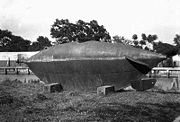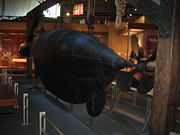
Bayou St. John Confederate Submarine
Encyclopedia


Submarine
A submarine is a watercraft capable of independent operation below the surface of the water. It differs from a submersible, which has more limited underwater capability...
built for use by the Confederate States of America
Confederate States of America
The Confederate States of America was a government set up from 1861 to 1865 by 11 Southern slave states of the United States of America that had declared their secession from the U.S...
during the American Civil War
American Civil War
The American Civil War was a civil war fought in the United States of America. In response to the election of Abraham Lincoln as President of the United States, 11 southern slave states declared their secession from the United States and formed the Confederate States of America ; the other 25...
.
Description
The submarine is constructed of riveted iron, 20 feet (6.1 m) long, 3 foot (0.9144 m) wide and 6 feet (1.8 m) deep, with a hand-cranked propeller.History
No period documentation for the submarine is known to exist, and its original name and many details about it remain unknown. The submarine was rediscovered in 1878 during a dredging of Bayou St. JohnBayou St. John
Bayou St. John is a bayou within the city of New Orleans, Louisiana.The Bayou as a natural feature drained the swampy land of a good portion of what was to become New Orleans into Lake Pontchartrain...
at its intersection with Lake Pontchartrain
Lake Pontchartrain
Lake Pontchartrain is a brackish estuary located in southeastern Louisiana. It is the second-largest inland saltwater body of water in the United States, after the Great Salt Lake in Utah, and the largest lake in Louisiana. As an estuary, Pontchartrain is not a true lake.It covers an area of with...
in New Orleans, Louisiana
New Orleans, Louisiana
New Orleans is a major United States port and the largest city and metropolitan area in the state of Louisiana. The New Orleans metropolitan area has a population of 1,235,650 as of 2009, the 46th largest in the USA. The New Orleans – Metairie – Bogalusa combined statistical area has a population...
, where the submarine was presumably scuttled to prevent it falling into Union hands after the U.S. capture of New Orleans (see: New Orleans in the American Civil War). It was put on display beside the bayou
Bayou
A bayou is an American term for a body of water typically found in flat, low-lying areas, and can refer either to an extremely slow-moving stream or river , or to a marshy lake or wetland. The name "bayou" can also refer to creeks that see level changes due to tides and hold brackish water which...
at Spanish Fort Amusement Park
Spanish Fort, New Orleans
Spanish Fort, also known as Old Spanish Fort, Fort St. Jean, and Fort St. John, is a historic place in New Orleans, Louisiana, formerly the site of a fort and later an amusement park.-The fort:...
as a curiosity, incorrectly identified as the Confederate submarine Pioneer
Pioneer (submarine)
Pioneer was the first of three submarines privately developed and paid for by Horace Lawson Hunley, James McClintock and Baxter Watson.Hunley, McClintock and Watson built Pioneer in New Orleans, Louisiana...
. (The traditional identification as the "Pioneer" was not called into serious question until historical research in the late 20th century showed the "Pioneer" to be of different design than the one rescued from Bayou St. John.) The Bayou submarine and the Pioneer may have undergone trials at about the same time and confusion between the two may date back to contemporary accounts; it is not clear which of the two was constructed first.
In 1908 the submarine was moved to the grounds of Camp Nicholls Confederate Home on Moss Street beside Bayou St. John. About this time, the interior of the submarine was filled with concrete in an attempt at preservation that later generations of conservators would find questionable.
In 1942 the submarine was acquired by the Louisiana State Museum
Louisiana State Museum
The Louisiana State Museum , founded in New Orleans in 1906 and still headquartered there, is a complex of National Historic Landmarks housing thousands of artifacts and works of art reflecting Louisiana's legacy of historic events and cultural diversity....
and moved to Jackson Square
Jackson Square, New Orleans
Jackson Square, also known as Place d'Armes, is a historic park in the French Quarter of New Orleans, Louisiana. It was declared a National Historic Landmark in 1960.-Design:...
; after being in various displays around the Square it was placed in the shelter of the arcade of the ground floor of The Presbytere
The Presbytere
The Presbytère, also known as The Presbytere, is an important historical building in New Orleans, Louisiana and is located in the French Quarter along Jackson Square, adjacent to the St...
in 1957, where it would remain until 1999.
In 1999 the submarine was transported to Baton Rouge, Louisiana
Baton Rouge, Louisiana
Baton Rouge is the capital of the U.S. state of Louisiana. It is located in East Baton Rouge Parish and is the second-largest city in the state.Baton Rouge is a major industrial, petrochemical, medical, and research center of the American South...
, where the old concrete was removed as part of major restoration work, after which the submarine was placed on display at the Baton Rouge branch of the Louisiana State Museum.

